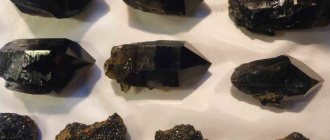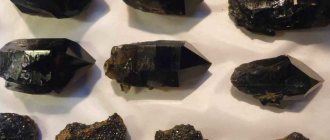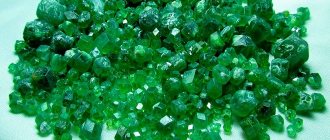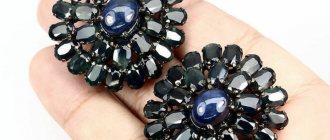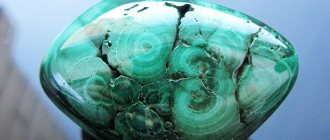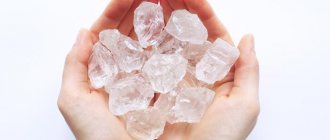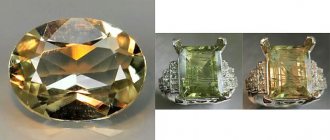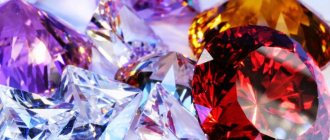Classification of precious stones. Varieties of precious stones by color. How to identify a real stone among the many fakes, imitations and hacks?
Today, jewelry specialists have a much more difficult time than their predecessors. If a few decades ago a genuine gemstone could be easily distinguished from a fake, even visually, then in the world of modern technology and progress it is almost impossible to do this by eye.
In addition to the well-known hacks made of glass, imitators of expensive stones from cheaper minerals, a new product has appeared on the jewelry market today - stone grown in laboratory conditions. Such a creation of human hands visually looks no worse than a mineral created by nature over many decades, but it costs several times less. How to distinguish a genuine natural stone from a fake or artificial stone? What precious minerals even exist?
Black gems: name, description, photo
Black gemstones
There are so many minerals in nature that stand out for their black color. Some of them are so rare that it is almost impossible to find any information about them. In many cases, the name “black” stone can be considered relative, since in fact the mineral has a lighter or non-uniform color. Here are the most common black stones in jewelry:
Gems
Black diamond or carbonado
Black Diamond is the greatest rarity and value in jewelry. However, it is worth noting that it never reaches the level of jewelry, since its cutting and processing is very complex - it can only be done using the same stone. In the annals of jewelry there are only a handful of such stones, the most expensive of which was estimated at 1.7 million dollars. The other two became known as "Black Star of Africa" and "Korloff Noir".
Black Diamond
Black sapphire
True black sapphire does not exist in nature. Almost all black sapphires are the work of scientists. They are obtained by processing blue sapphires. The few black sapphires that are of natural origin can hardly be called black, since their color is closer to the color of the sky at night. The most famous black sapphire is the Black Star of Queensland, worth $100 million.
Black sapphire
Black Pearl
This type of pearl is also difficult to consider truly black, since its darkness is softened by the mother of pearl of the pearl. However, the cost of such a curiosity remains quite high to this day. The rarest specimens of black pearls are collected in Tahiti in the corresponding museum.
Black Pearl
Black opal
This type of opal is considered one of the most expensive and valuable rocks. Most often, this mineral is found in deposits located in the least developed countries of the world, which causes numerous human losses during its extraction.
Black opal
Black spinel
Black spinel is one of the most inexpensive types of black gemstones. Its cheapness is easily explained by the fragility of the stone and the complexity of its processing. Most often, spinel is used in needlework or jewelry in the form of cabochons.
Black spinel
Semiprecious stones
Black quartz or morion is the only representative of semi-precious stones of black color. This mineral is most often used in jewelry today. Externally, it has an opaque or barely transparent surface.
Black quartz or morion
Jewelry and ornamental stones
Black agate
In fact, black agate does not exist in nature. Only dark coal-colored minerals can be found. A rich black color can only be achieved through technological processing of this stone.
Black agate
Other representatives of black jewelry and ornamental stones are: black onyx, obsidian, black jasper or jet, hematite, argillite and hypersthene.
White gemstones: name, description, photo
White gemstones
White or naturally transparent minerals are considered the most expensive and valuable stones in jewelry. White gemstones include:
Diamond or diamond
It is a transparent diamond or an already cut part of it (diamond) that first comes to the mind of any person (especially women) when mentioning white precious stones. Indeed, this mineral is considered one of the most sought after. Its high cost is easily explained by the few deposits of this mineral in the ground. At the same time, only a small fraction of all mined diamonds are suitable for cutting.
Diamond
Transparent spinel
Unlike its black counterpart, white spinel is a fairly expensive stone with a high strength. The impeccable purity and the fact that this mineral contains no impurities makes it even more valuable. White spinel is most often used in luxury jewelry.
White spinel
Colorless topaz
With the naked eye, this mineral can easily be confused with a diamond. However, upon closer inspection, differences can be detected. In jewelry, it is customary to frame colorless topaz in noble white metals - gold, platinum.
White Topaz
Goshenite or colorless beryl
Goshenite is also very similar in appearance to diamond, but its shine can rather be called more chilling and restrained.
Goshenite
Pearl
White pearls have always managed to captivate the fair sex with their warmth and tenderness. Oddly enough, in nature, pearls rarely have a round shape (such representatives are highly valued) - more often they are oblong and uneven. Pearls also have one more feature - their lifespan. If ordinary minerals will delight the eye with their beauty forever, then a pearl can “go out” at any moment. The lifespan of this mineral does not exceed 300 years.
White pearls
Achroite or white tourmaline
This type of rock is very rare, since its deposits are located in only one point on the map. Achroite is quite rare in the form of jewelry. This kind of pleasure can only be ordered from a few jewelry workshops in the world.
White tourmaline or achroite
Semi-precious white stones include white agate, rock crystal and white opal.
Jewelry and ornamental stones can boast of the presence in their list of such white minerals as milky coral, white jasper, moonstone, and white-green jade.
Gemstone concept. Features of terminology
There is currently no general definition of the concept of “precious mineral” in the world. In most cases, this group includes stones that meet 3 requirements:
- beauty of appearance;
- uniqueness;
- strength.
In the first case, gloss, play of light, shimmer and optical properties such as dispersion and pleochroism are assessed. The difficulty of finding such minerals or their minimal content in rocks causes a “scarcity”, making the gems more unique and thus ensuring a growing demand.
Durability is directly related to the strength, hardness and density of the gemstone. All these factors have a great influence on the formation of the market value of the gem.
If we talk about the legal side, then according to Russian laws the following are classified as precious materials:
- diamonds;
- rubies;
- emeralds;
- natural alexandrites;
- sapphires;
- unique amber formations;
- natural sea pearls.
Evaluation criteria for any characteristics are not specified. Most likely, the selection was made on the basis of a list of in-demand precious materials, whose circulation the state seeks to control.
Interesting! Unofficially, there are several classifications of precious stones. Each country decides which estimation method to use and how to make the breakdown.
Blue gems: name, description, photo
Blue gemstones
Blue or cornflower blue sapphire
Only an experienced specialist will be able to distinguish these two types of mineral by eye. Blue sapphire is valued somewhat lower than cornflower blue sapphire, but it is still considered a precious stone. As for the cornflower blue sapphire, in ancient times it was used only for inlaying royal outfits and jewelry.
Blue sapphire
Cornflower blue sapphire
Topaz
Topaz is most often found in blue, but in nature it also comes in other colors - yellow, green, orange, etc. Topaz is not an overly expensive mineral. Most often it is framed in white precious metals - platinum, white gold. Such metals seem to emphasize its gentle radiance.
Blue Topaz
Aquamarine
Already from the very name of the mineral, its origin and associations associated with it become clear. The marine color of this stone helps jewelers create masterpiece blue jewelry. Aquamarine lovers should pay attention to the fact that this mineral is quite fragile - exposure to chemicals, mechanical damage and heat treatment negatively affect its condition.
Aquamarine
Blue spinel
This color of stone is extremely rare, which determines its rather high price. Framed, it can only be found in exclusive creations by jewelers, which are often kept in private collections and cost tens or even hundreds of thousands of dollars.
Blue spinel
Semi-precious blue stones include: zircon, chalcedony. Turquoise, apatite, bezoar, and amazonite are considered ornamental blue stones.
Semi-precious yellow stones
Semi-precious solar minerals are more common:
- Citrine - its very name speaks of its lemon color. The intensity of the shade ranges from light to dark; the darkest crystals are called “madeira”.
- Zircon is a transparent crystal with a golden hue. It is rarely used in its natural form. It is subjected to heat treatment, as a result of which the crystals become red or turquoise.
- Heliodor is a variety of beryl with a golden-honey hue. The name translates as “gift of the sun.” Crystals of deep yellow color are the most valuable.
- Garnet - honey color is rare for this gem. The crystals are called “andradite”.
In addition to natural crystals, honey color is given to artificially grown stones - nitrogen topaz, bernite. Semi-precious stones are used to make jewelry.
Blue gems: name, description, photo
Sapphire
gemstones
Blue sapphire
Topaz
Blue Topaz
Lapis lazuli
Lapis lazuli is a gemstone that is most often set in yellow gold. This mineral is believed to have strong healing and protective properties.
Lapis lazuli
Semi-precious blue stones include turquoise, the color range of which includes dozens of shades of blue, green and light blue.
Turquoise
Red gemstones: name, description, photo
Red gemstones
Ruby
Perhaps every person, when mentioning red gemstones, immediately thinks of ruby. This stunningly beautiful mineral is very widely used in jewelry. It is framed in various kinds of precious metals - gold, platinum, silver. A piece of jewelry inlaid with ruby can be quite expensive - everything will depend on the metal, as well as the number and size of minerals. Since ancient times, rubies have been credited with many magical and healing qualities. This stone has always been associated with love, passion and desire.
Ruby
Red tourmaline
Red tourmaline
Red spinel
Red spinel
Semi-precious red stones include garnet, zircon, carnelian, and coral.
Garnet, carbuncle or pyrope
In the myths of various ancient states there were very frequent references to this mineral. It was believed that pomegranate was able to heal many ailments and block the effects of poison and poison.
Pomegranate
As for ornamental stones, the most famous representative of them in red color is jasper.
Red Jasper
Main conclusions
The yellow tint is not as common in nature among precious and semi-precious stones as, for example, red or green. In some cases, it increases the price of the stone, however, only if this shade is natural. The description of the mineral always indicates the origin of the color (natural or acquired under the influence of temperature).
- The most expensive yellow gemstone is the golden diamond.
- Semi-precious and semi-precious stones are actively used not only in the jewelry industry, but also in applied arts, design and decoration.
- Synthetic varieties of minerals are actively used in industry.
Bright yellow stones like the sun will fill you with positivity and joy and will be an excellent addition to your image or home interior.
Share your impressions of what you read and leave feedback in the comments.
Pink gemstones: name, description, photo
Kunzite
Gems
Until recently, this soft pink gemstone was not classified as a separate subgroup - it was simply considered one of the varieties of amethyst. However, thanks to the works of the American Kunz (by whose name it was named), this mineral, based on its composition, different from amethyst, was nevertheless recognized as a completely different stone.
In the early 90s, kunzite attracted the attention of the entire public. He owed such popularity to the Kennedy family. The fact is that the American president, on the eve of his tragic death, purchased Jacqueline a ring inlaid with kunzite. But John was never destined to give the gift to his beloved wife - he was shot dead a month before the celebration.
Kunzite
Morganite or pink beryl
Morganite (in Russia sparrowite) is a rather rare mineral. Most often it is used to decorate products in the company of diamonds.
Pink beryl or morganite
Rubellite or pink tourmaline
Rubellite is a fairly inexpensive, but no less beautiful gemstone. Its resemblance to a ruby played into the hands of scammers in ancient times. It was this mineral that was used to counterfeit more expensive rubies.
Rubellite
Semi-precious pink stones include quartz, agate, and corundum. As for ornamental stones, nature often colors jasper, coral, rhodochrosite and rhodonite pink.
Green gemstones: name, description, photo
Green gemstones
Emerald
Naturally, the most famous green gemstone is the emerald. Few people know that in its original form this mineral can hardly be called beautiful - only after high-quality cutting can one recognize it as the king of green stones. Emeralds are most often framed in yellow metals. In white version they can only be found in company with white gold and platinum. The price of emeralds is sometimes simply fabulous - from $300 per carat.
Emerald
Demantoid or green garnet
The high refractive index of the sun's rays of the demantoid raises it to the level of the most regal stone - diamond. Most often, green garnet is confused with emerald, although its color, unlike the latter, is closer to the color of grass. For one carat of this gemstone you will have to pay from $100 to $1000.
Green pomegranate
Green tourmaline
Green tourmaline
Green sapphire
Green sapphire
Semi-precious green stones include: peridot, aventurine, beryl, seraphinite.
Green ornamental stones most often include jasper, malachite and jade.
Classification of ornamental stones
Ornamental minerals are divided by hardness according to the Mohs scale:
- Hard (from 5 points) – labradorite, quartzite, jasper, hornstone, amazonite granite. On a hard surface, the knife blade leaves no mark.
- Medium hardness (from 3 to 5 points) - coil, marble, fluorite, onyx. A slight impact with a saw or knife leaves a scratch on the stones.
- Soft (less than 3 points) - graphite, alabaster, selenite, stearite, pyrophyllite. The surface of minerals is easily damaged by any hard object, nail, or pen.
The ornamental stones of the Urals are diverse.
Since the 17th century, the richest deposits of gems in the Ural Mountains have been developed. In hundreds of mines, going deep underground, where not a single ray of sunlight penetrates, precious veins of rock are hidden - smoky quartz, the best red-purple amethysts in the world, green malachites.
See review:
Burgundy gemstones: name, description, photo
Ruby
gemstones
Burgundy ruby
Tourmaline
Burgundy tourmaline
Semi-precious garnet can also have a beautiful burgundy color.
Pomegranate
How to distinguish natural stone from fake, from glass in jewelry?
How to distinguish a real gemstone from a fake?
It will not be difficult for a high-class jeweler or appraiser to identify the authenticity of a stone using special tools and devices. As for the inexperienced layman, it will be very difficult for him to distinguish a real stone from a fake. In such cases, professionals recommend using the following techniques:
- Natural stone, as a rule, is much stronger than glass or plastic fakes. If you run a sharp object over it, there should be no mark left on it. In this case, a scratch may form on the fake. But this method is relevant only when it is necessary to distinguish hackwork from a real stone - if the product uses a natural, but less expensive mineral instead of a top-level precious stone, then there is no point in conducting such an experiment.
- Natural stones have a cool touch. If you put a stone on your tongue or apply it to your cheek, it will remain cold for a long time. If the product uses glass or plastic, the stone will heat up quite quickly.
- Natural stones grown in the depths of the earth are rarely large, but artificial minerals created in laboratories can reach more impressive sizes.
- The color of natural stone is rarely very rich and bright. At the same time, creating hackwork of any color and shade is quite simple.
- You should not expect that a natural stone will cost a penny - the price per carat of a precious mineral can reach thousands and hundreds of dollars.
- When purchasing a product with natural stones, you can ask the seller to provide a certificate of authenticity of the stones.
In fact, all precious minerals have completely different chemical and physical properties. Therefore, the identification of each of them must be approached individually.
Magical and healing properties
Golden color has a positive effect on a person’s life:
- gives optimism;
- gives self-confidence;
- reveals creative abilities;
- improves mood.
Amulets with golden crystals promote career success and help you find family happiness. Esotericists recommend wearing amulets for people who are unsure of themselves.
A person's dream of a yellow crystal portends good luck. Old debts are returned, there is a promotion at work. For women, this often portends a successful marriage. If you had such a dream on the eve of a business meeting, the outcome will be successful.
The golden color of gems is most suitable for the fire signs of the zodiac - Leo, Aries, Sagittarius. For representatives of these signs, the stone will become a real talisman, bringing good luck in business and personal life.
Representatives of other signs will also benefit from yellow gems. They improve your mood, help you cope with life's difficulties, and improve your health.
The healing properties of golden stones allow them to be actively used in lithotherapy. With the help of yellow minerals, diseases such as:
- cholelithiasis;
- chronic hepatitis;
- thyroid diseases;
- anemia.
The honey hue is associated with the liver, because bile also has this color. Therefore, gems are used to treat diseases of the gastrointestinal tract. Carnelian is especially suitable for this purpose.
For diseases of the thyroid gland, lithotherapists recommend wearing amber beads. Zircon affects the nervous system, helps cope with neuroses and depression.
Watch a video about the magic of yellow stones:
